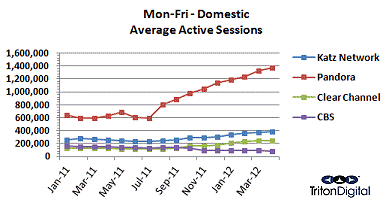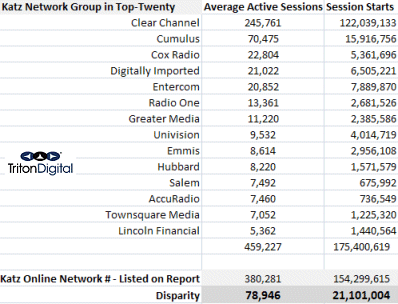 Analytics, Metrics and Music for the Radio Industry
Analytics, Metrics and Music for the Radio Industry
 An Indie Artist Pipeline to Internet Radio
An Indie Artist Pipeline to Internet Radio
 Radio Industry ROI Strategy
Radio Industry ROI Strategy
 A New Breed of Indie Artists
A New Breed of Indie Artists
Pen in Unknowing Hand is Dangerous
I must have read the sentence ten times: "Aprilís Triton Digital Webcast Metrics report shows in dramatic fashion the hockey-stick growth internet radio listening has experienced during the past 12 months." I pulled up data sets each time, stared at the graphs, and tried to see what I was missing.
| "I do the breakout for you, and show what the radio industry is doing online in more detail than is available from any other source." |
If anyone at Inside Radio wants to inform me of where this "hockey-stick growth" is, I'd appreciate the insight. Excluding Cumulus gaining Citadel's stations and Slacker absorbing AOL Radio, what I'm seeing shows only Pandora with "hockey-stick growth." The rest of the stations appear in a state of slowly acquiring listeners, who are sticking around for less time (if you look at Time Spent Listening trends). |
Each time a Webcast Metrics is released I put together the data in a way that allows you to see the deeper picture. Download these spreadsheets free.
Here's the problem from my perch. It appears Clear Channel is on an all-out attack to impress upon the radio industry that it now covers all media, especially digitally-delivered media. What better way to plant the idea that this digital delivery is taking off than to take its company-owned trade magazine and start planting a visual of "hockey-stick growth."
Only let's take a close look at what's happening, and you tell me if you see what I see when what you're looking at is explained.
Take the second sentence in the Inside Radio article about Triton Digital Webcast Metrics' April numbers: "For the first time there were more than 2 million Average Active Sessions (Mon-Fri, 6a-8p) among the top 20 webcasters in one month, a 71% increase over April 2011." View this graph to see how the top 4 listings compare. (Download the complete report here.)

As a whole, Triton Webcast Metrics show - are you ready for this - nothing! It is a compilation of numbers from a diverse set of companies which hold nothing in common. Add a client, and the total number of monthly listening sessions goes up with respect to that client's audience. Lose a client, and the total Top 20 Rankers go down (unless another company makes up the difference).
We're not dealing with deep analytical analysis here. So I'm wondering why anyone would place a definitive explanantion of internet radio's growth as "hockey-stick," based on what's in the April rankers.
But here's another deep-deep problem for Inside Radio, which apparently has not gotten the message from its boss Robert Pittman that Pandora is not "radio." Dissect the top companies between April 2011 and April 2012 (Pandora, Clear Channel, CBS, and Katz as a network), and you'll see that 86% of this growth in "Monday-Friday Average Active Sessions" - from the top-4 reporting companies - comes from Pandora.

This makes internet radio's "hockey-stick growth" questionable if Pandora is not radio.
It's more questionable when you start tallying the figures which appear in the April Triton Digital Webcast Metrics for all of its Top 20.
Here is an item that simply doesn't make sense. If Katz Online Network has at least 14 companies (those appearing in the Top 20 Rankers) plus more (those which don't appear), you'd expect the numbers for Katz Online Network to be more than the total of the 14 top-listed online radio groups. They aren't, as this chart shows.

Fact is, if you aggregate the Top 20 Ranker numbers for Average Active Session, you'll find Katz Network totals 78,946 less than if you tallied each of its "network" stations individually. Do the same with Session Starts and we have a discrepancy of over 21 million fewer being reported by Katz than if (just) the Top 20 "network" stations are added together.
I'm not attempting to discredit Triton Digital Webcast Metrics or Inside Radio. What I am doing, though, is showing how just staring at an assembly of numbers without diving into them to see if they tell you anything of importance is, well, important.
Growing the online radio industry can't be done with smoke and mirrors, not when we have exact numbers laid out to digest. A better way of saying this is that you cannot place numbers in front of trade journal writers and then let them write about what they represent, if there's been no analysis of the data being written about.
If Pandora is not accepted in the radio industry as "radio," there is no "hockey-stick growth" for online radio. Therefore, writers at Inside Radio need to get with the CEO of Clear Channel to see how this should be handled in the future.
There also appears to be a disconnect between what's reported as Katz Online Network numbers and what's reported in the listing of the Top 20 Rankers from Triton Webcast Metrics.
I'm behind the push to show how people are gravitating towards listening to more radio online, and that there is a future in dealing with the solid numbers given by server logs. But it will do no good to display numbers if nobody in a position of reporting what these numbers mean, reports what they mean. And, as they are laid out, the numbers mean nothing.
On an individual basis, grabbing server log data and relaying it to clients is a valuable tool. But to get the radio industry into a frenzy on each release of these "Top 20 Rankers" is an exercise in futility. Especially when you consider that the Triton Webcast Metrics do not represent the online radio industry at large, but only its paying clients.
As for Inside Radio's reporting, I'll strongly suggest (though I know its management will never consider this) that instead of reporting in an opaque fashion, it digs deeper into what's on the spreadsheet. Perhaps then the real story will come out, and we'll finally get to see if Clear Channel considers Pandora "radio," or not.
Go here to download your free Audio Graphics analysis of the Triton Digital "April 2012 Internet Audio Top 20 Rankers."
Return to AudioGraphics.com each time there is a new "Internet Audio Top 20 Rankers" released from Triton Digital. I do the breakout for you, and show what the radio industry is doing online in more detail than is available from any other source.
Click here to receive a FREE breakout of this report sent to you for each ranking month. It includes all groups in the publicly-released Triton Digital Ranker.
Note: For caveats pertaining to this month's release, please view the bottom of Triton Digital's report.









